|
|
|
Sort Order |
|
|
|
Items / Page
|
|
|
|
|
|
|
| Srl | Item |
| 1 |
ID:
110161
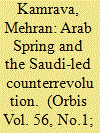

|
|
|
|
|
| Publication |
2012.
|
| Summary/Abstract |
The author contends that the Arab Spring has provided an opening for the Gulf Cooperation Council as a group and for Saudi Arabia as a long-time aspiring leader of the Arab world to try to expand their regional influence and global profile. An already weakened Arab state system, he argues, has been once again weakened by the sweeping wave of rebellion.
With its final chapter yet to be written, the Arab Spring of 2011 is likely to go down in history as a season of profound political changes that swept across the domestic politics of the Arab world. Even at this preliminary stage, that much is clear. What remains unclear, however, is how political change sweeping across the Middle East and North Africa is likely to alter the international relations of the Arab world in general and, in particular, the larger regional position and specific policy preferences of the Gulf Cooperation Council (GCC). Important considerations include the GCC's posture and profile vis-à-vis the Arab Spring, its collective reaction to the region-wide movements for political change, and its delicate relationship with its two troubled neighbors to the north, namely Iran and Iraq.
While the Arab Spring is unlikely to result in meaningful changes in Iran and Iraq's relationships with the GCC, it has fostered two discernible trends in the larger Arab world. First, Saudi Arabia has sought to reassert its position of prominence and leadership within the GCC. In fact, the kingdom has positioned itself as the chief architect of a counterrevolution to contain, and perhaps to even reverse, the Arab Spring as much as possible. Second, and an outgrowth of the first development, is the GCC's attempt to solidify its identity and mandate through the inclusion of additional Sunni monarchies-Morocco and Jordan-as a counterbalance, if not a substitute, to the Arab League.
|
|
|
|
|
|
|
|
|
|
|
|
|
|
|
|
| 2 |
ID:
110157
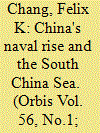

|
|
|
|
|
| Publication |
2012.
|
| Summary/Abstract |
Over the last fifteen years, the steady rise of China's naval capabilities has received a level of attention unmatched since the Soviet navy's expansion following the Cuban Missile Crisis. Yet much of that attention has focused on what that rise has meant for Taiwan's security or a possible contest with the United States.1 But Beijing's seaward territorial concerns also reach far into the South China Sea. And it is there that the military balance has most swiftly swung in China's favor as a result of its modernization program. This article will examine not only how the military balance has shifted, but also what Southeast Asian countries, particularly Vietnam and the Philippines, could do to best preserve their territorial interests in response to that shift.
|
|
|
|
|
|
|
|
|
|
|
|
|
|
|
|
| 3 |
ID:
110158
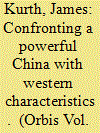

|
|
|
|
|
| Publication |
2012.
|
| Summary/Abstract |
The rapid rise of Chinese economic and military power has produced the most fundamental change in the global system since the end of the Cold War, and it poses vital questions about China's future direction. Many Western analysts argue that China's great power will cause it to become more like the West, i.e., like Western great powers. Other Western analysts believe that China will continue to be the same, i.e., like the China of the past few decades. An alternative interpretation, however, is that China's new power will enable it to become even more Chinese than it is now, i.e., to become more like the traditional and imperial China that existed before the Western intrusions of the 19th century. This China was the "Central State" of a distinctive Chinese world order, operating with distinctive conceptions about diplomatic relations, military strategy, and economic exchange. However, the new China will be unlike the old China in at least two important ways. It will be a naval, and not just a land, power, and it will be a financial, and not just a trading, power. In other words, it will be a powerful China with Western characteristics. As a formidable naval and financial power, China will present fundamental challenges to the United States and to both the long-standing U.S. security order in the Western Pacific and the long-standing "Washington Consensus" about the global economic order.
There was once a great power, one so great that its power not only reached all around the world, but it was recognized as the world's leading power. Its economic practices, political system, and conceptions of international law provided the models and set the standards for numerous other powers. And at the core of its power, and backing up its models, was a special form of military power-the greatest navy in the world-and a special form of economic power, the greatest financial system in the world. That great power was Great Britain, that navy was the Royal Navy, that financial system was centered in the City of London, and that era was just a century ago. However, the greatness of British power had been established almost a century before that, after Britain's victory in the Napoleonic Wars. That victory had largely been won with the advantages provided by the Royal Navy and the Bank of England.
|
|
|
|
|
|
|
|
|
|
|
|
|
|
|
|
| 4 |
ID:
110162
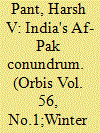

|
|
|
|
|
| Publication |
2012.
|
| Summary/Abstract |
The risks to global security from a failure in Afghanistan are great. Abandoning the goal of establishing both a functioning Afghan state and a moderate Pakistan places greater pressure on Indian security. Pakistani intelligence would be emboldened to escalate terrorist attacks against India once it is satisfied that the Taliban would provide it strategic depth in Afghanistan. This would surely force retaliation from India.
As the strategic realities in South Asia radically altered after Osama bin Laden's death on May 2, 2011, the Indian Prime Minister, Manmohan Singh, lost no time in reaching out to Afghanistan with his two day visit to Kabul. There he announced a fresh commitment of $500 million for Afghanistan's development, over and above India's existing aid assistance of around $1.5 billion.1 New Delhi and Kabul agreed that the "strategic partnership" between the two neighbors, to be implemented under the framework of a partnership council headed by the foreign ministers of the two nations, will entail cooperation in areas of security, law enforcement and justice, including an enhanced focus on cooperation in the fight against international terrorism, organized crime, illegal trafficking in narcotics, and money-laundering. The Indian Prime Minister was presented with a rare honor, addressing a joint session of the Afghan Parliament to underscore Indo-Afghan unity in fighting extremism. Most significant was Singh's expression of his country's support for the Afghan government's plan of national reconciliation involving Taliban insurgents, thereby signally an end to India's public opposition to a deal with the Taliban, and bridging a strategic gap with the United States.2
Though initially Singh was to visit Kabul earlier, the United States persuaded the Indian government to postpone the visit. The reasons for this request became clear later, but it allowed New Delhi to express its urgent regional foreign policy priorities to the international community at a time when the Obama Administration has made categorical its intention to end the combat role of American forces in Afghanistan by 2014.
|
|
|
|
|
|
|
|
|
|
|
|
|
|
|
|
| 5 |
ID:
110163


|
|
|
|
|
| Publication |
2012.
|
| Summary/Abstract |
Elegant strategies can be constructed without reference to intelligence but persuading policymakers to implement them without knowing what intelligence might have to say about their likely efficacy and unintended consequences would be exceedingly difficult. Intelligence-derived information and insights should not dictate the goals of grand strategy, but they should inform decisions about what to do, how to do it, and what to look for in order to assess how well or badly the strategy is working.
The relationship between intelligence and grand strategy is similar to the relationship of intelligence to policymaking. Grand strategists, like policymakers, can-and often do-formulate plans and develop policies without seeking or heeding information and insights from intelligence analysts.1 History is replete with examples of smart people who developed compelling theories of international relations and/or effective strategies to protect and pursue the interests of their countries without reliance on inputs from spies, satellites, analysts, or other accoutrements of intelligence.
|
|
|
|
|
|
|
|
|
|
|
|
|
|
|
|
| 6 |
ID:
110160


|
|
|
|
|
| Publication |
2012.
|
| Summary/Abstract |
The Arab Spring has fundamentally shifted the strategic balance in the Middle East. As all sides rush to ensure that their interests will be secured, the Hashemite Kingdom of Jordan has emerged as a key battleground between those who would like to see a more democratic region, and those who would like to maintain economic stability. On one side of this debate is the Gulf Cooperation Council, led by Saudi Arabia, that views democratic reform as a threat to economic stability. On the other side are the forces of the Arab Spring, which have called for political reform in states such as Egypt, Syria, and Libya, even if these reforms come at the expense of stability. This article examines the various forces, both domestic and international, that are attempting to influence Jordan, and through it, the balance of power in the Arab World.
The uprisings in the Arab world have not only upended domestic politics in individual states where protests have taken place, they have also served as a catalyst for transforming international relations in the Middle East. The Arab Spring has sent policymakers on all sides scrambling to ensure that the new regional order will be in line with their interests. The regimes that fell in Egypt and Tunisia were pillars of a moderate Sunni bloc that was allied with the United States and felt threatened by both Iran's bid for regional hegemony as well as Islamist and/or democratic reform movements domestically. The leaders of this moderate Sunni bloc, which also includes Saudi Arabia, the Gulf States, and Jordan, were alarmed by American support for the protest movements that ousted the Mubarak and Ben Ali regimes from Egypt and Tunisia respectively. The remaining states in this bloc have since circled their wagons, and are working to build a durable political/military alliance that is capable of withstanding the destabilizing trends associated with the Arab Spring.
However, unlike the wealthy Gulf Arab states, which now form the core of this truncated bloc, Jordan is poor and has always been more culturally and politically tied to the states of the Mediterranean Basin. Thus, the pull of the Arab Spring, which engulfed Egypt, Syria, and other Mediterranean states, has been much stronger in Jordan than it has in most of the Gulf Arab States (the major exception being Bahrain). Jordan, therefore, finds itself caught between two competing forces. On one side are the Sunni Monarchies of the Gulf, which wish to maintain regional economic and political stability and have attempted to bolster the Jordanian regime by recently inviting it to join the Gulf Cooperation Council (GCC). The other side presents pressures of political reform associated with the Arab Spring that have spread throughout the Mediterranean Basin. As an unexpected result, the small Arab Kingdom of Jordan has become a strategic battleground between those who want to see a more democratic region, and those who want to maintain the status quo. Nevertheless, the domestic politics of Jordan will undoubtedly decide in which direction Jordan heads. Political divisions inside Jordan have thus suddenly become very important to the future of the whole region.
|
|
|
|
|
|
|
|
|
|
|
|
|
|
|
|
| 7 |
ID:
110156
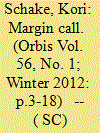

|
|
|
|
|
| Publication |
2012.
|
| Summary/Abstract |
America's military has proven incredibly effective and adaptive to the threats of the 9/11 era. It has not, however, been particularly cost-conscious. Insolvency is our gravest national security threat, and - thankfully - the Congress has finally gotten serious about dealing with it. Defense is in for a decade of austerity, of a magnitude that cannot be accommodated within current strategy and forces. Much higher risk will need to be accepted in how we fight our wars and address threats of lesser magnitude or longer lead times unless we find more innovative approaches. Foregoing counterinsurgencies, simplifying our war aims, protecting our advantages in creativity, restructuring military benefits, shifting greater responsibility to allies and emphasizing cost-exchange ratios in our operations will be necessary. It is a daunting list, and wearying to a military that has shouldered the burdens of wars for a decade with little contribution from our broader society. But it, or something like it, will also be necessary to redress the dangerous vulnerability or our debt.
Historian Arnold Toyenbee said that empires die by suicide, not homicide. Our country has been on a path to suicide by spending profligacy and it has resulted in a debt problem of enormous magnitude. This is our main strategic vulnerability, and our capacity to solve it will likely be the crucial test of whether American hegemony is perpetuated through the twenty-first century, or we have begun to decline.
Our country is facing a margin call. We have used borrowed money to purchase assets. Those assets are both discretionary (defense and other annual spending) and non-discretionary (entitlement payments and promises). External markets and internal regulators-in the form of the American electorate-have called into question whether we have the money to pay for the assets we have purchased. Receiving a margin call, the investor must either increase the amount of money on deposit or sell off assets.
Faced with difficult choices, the United States has two enormous advantages. First, Americans have acknowledged the problem and are engaged in an extended and boisterous debate on how to solve it. Second, U.S. military dominance is so substantial that we can absorb near-term risk of significant defense spending cuts in order to solve the larger strategic problem of our national indebtedness.
The coming cuts in defense will necessitate the first serious reconsideration in the 9/11 era of the strategy and requirements for U.S. military forces. The Department of Defense (DOD) is in the process of determining where to pare for the $450 billion in cuts that constitute the first phase of the budget reductions; the more vexing question is how DOD would accommodate the additional $600-800 billion that would come with sequestration or a second phase "super committee" agreement.
To operate within the constraints of such austerity, we will have to fight differently. The size of our forces will shrink further, even though they are already too small. We will not be able to sustain personnel-intensive wars like counterinsurgencies. The operational approaches available at lesser cost have daunting endogenous effects on our military and exogenous effects on the societies in territories where we will apply military force. We will become more reliant on reconstitution, extending the timelines beyond what we have come to take for granted as immediate availability of forces and rapid execution of war plans.
We may also need to forego important recalibrations, like allowing the Marine Corps to differentiate itself from the Army and refocus on amphibious operations, and the long overdue returning of the national guard and reserve to their traditional roles. Spending in other national security agencies-on which current war strategies rely-is almost certain to be reduced even more than in DOD, calling into question our ability to conduct "whole of government" operations. These developments w
|
|
|
|
|
|
|
|
|
|
|
|
|
|
|
|
| 8 |
ID:
110164
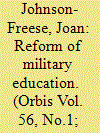

|
|
|
|
|
| Publication |
2012.
|
| Summary/Abstract |
When considering how to make the war colleges more effective, it should be remembered that first and foremost, the job of the war colleges is to educate students to make them better defenders of the United States of America and its interests and its allies around the world. However, the author gives many recommendations on how these colleges can better educate, rather than train.
It has been 25 years since the landmark 1986 Goldwater-Nichols Act reformed U.S. national defense. Part of that important legislation specifically mandated guidelines for military education, with intent to open the military culture and to encourage intellectual integration with civilians and among the services themselves. This was followed by the "Skelton Panel," chaired by Rep. Ike Skelton (D-MO). The idea behind both was simple, reflecting the classic wisdom that "the society that separates its scholars from its warriors will have its thinking done by cowards and its fighting done by fools.1 "Over a decade earlier, Admiral Stansfield Turner had similarly reformed the Naval War College (NWC), warning that if military officers could not hold their own with the best civilian strategists, the military would end up "abdicating control over its profession."
In 2010 the House Armed Service Committee issued a report titled Another Crossroads? Profession
|
|
|
|
|
|
|
|
|
|
|
|
|
|
|
|
| 9 |
ID:
110159


|
|
|
|
|
| Publication |
2012.
|
| Summary/Abstract |
This study of Buddhist, Taoist, and Christian relations across the Taiwan Strait elicits three observations: (1) officials on both sides of the Strait are permitting increased cross-Strait religious interaction, but each side has different calculations for doing so; (2) each side uses religion as "soft power" to obtain its political objectives, but these low-key approaches are limited-for different reasons; and (3) even though cross-Strait religious ties are defined by the governments and religious organizations in Taiwan and China in cultural terms, they have significant political implications.
Religious relations across the Taiwan Strait are under-studied and under-reported. Yet cross-Strait religious interaction can have important consequences, such as social integration or pressures on both Beijing and Taipei for changed policies and practices. For Beijing, religious relationships are one of five key links on which Hu Jintao's government has focused attention in an effort to build a harmonious society.1 For Taipei, friendly cross-Strait religious relations help to achieve détente with China.
The study elicits three observations. The first is that officials on both sides of the Strait are permitting increased cross-Strait religious interaction, but each side has different calculations for doing so. From the Taiwan side, accommodation of increasing religious exchanges is instrumental to peace with China, and perhaps to inducing China's political liberalization. In Beijing, officials use cross-Strait religious ties as a non-threatening means to draw Taiwan closer to unification.
The second observation is that each side of the Strait uses religion as "soft power" to obtain its political objectives, but these low-key approaches are limited. Taiwan's approach is circumscribed because China in significant ways controls and manipulates cross-Strait religious exchanges. Some people of Taiwan find the call from China to honor their historical roots by connecting with religious sites in the "motherland" particularly compelling. This strategy, too, is limited, however, because of the intellectual and organizational growth that has been attained by many of Taiwan's religious institutions.
The third observation is that even though cross-Strait religious ties are defined in cultural terms by both governments and religious organizations in Taiwan and China, they have significant potential political implications. Because Taiwan is a democracy, the government in Taipei cannot pry into its citizens' private business, and therefore monitors only Chinese visitors who come to Taiwan for religious purposes. Taiwan has no knowledge of the number of visits made by its people to China that involve religious exchanges. In contrast, the government in Beijing guards against challenges that can arise from religions, and maintains vigilance about all religious interactions in both directions across the Strait. Governments and religious organizations on both sides of the Strait are aware of the increased religious interactions, but every player is mindful that religious organizations and exchanges can be the micro-foundation for political change.
The focus of this study is on Buddhism, Taoism, and Christianity. Ninety-three percent of Taiwan's religious population practices Buddhism and Taoism. Only 4.5 percent practices Christianity, but Christians have wielded substantial influence in Taiwan's social development and political history. Only 2.5 percent of the religious population professes a religion other than Buddhism, Taoism, and Christianity. The article discusses the ways in which cross-Strait religious relations are unfolding, and considers the political implications in regard to each of the three religions. The conclusion summarizes the systematic analysis of the patterns of interactions and their political connotations.
|
|
|
|
|
|
|
|
|
|
|
|
|
|
|
|
|
|
|
|
|